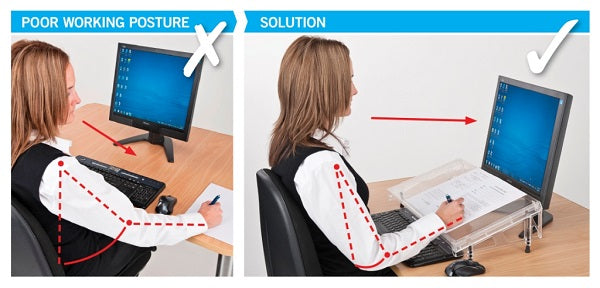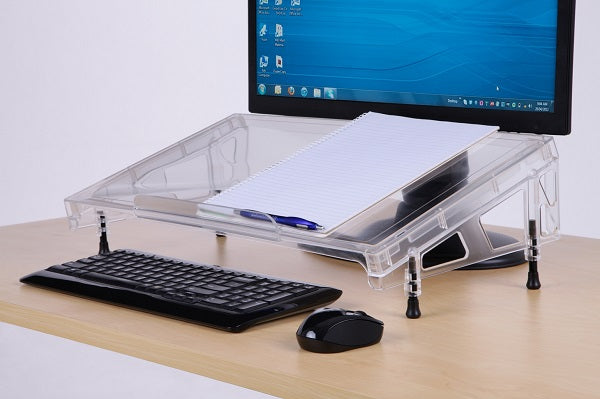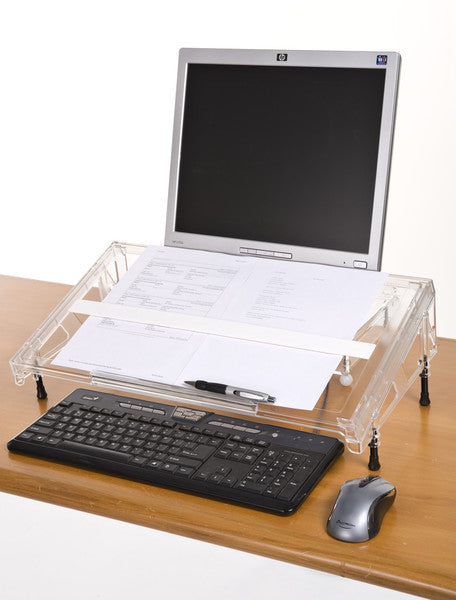My journey to the Microdesk - Guest Blog By Sarah Mahoney

I found my physio treatment eased symptoms initially, but they returned almost instantly once the patient went back to work. To say I felt I was fighting a losing battle is an understatement. So I took up the banner of waging war on musculo skeletal problems in the workplace by leaving the physio clinic behind and heading out into offices with my newly written ‘Program for Good Use’ – designed to educate people on the cause of their problems, in the hope they could then avoid the need for any treatment at all.
Refreshingly, I had good management buy in as companies faced increases in their work cover insurance bills. These new claims being made for workplace injuries were not something that traditionally appeared on the expense sheets of white collar, knowledge sector companies. They associated such costs with blue collar jobs operating heavy machinery but were fast realising that working with any machine for hours on end, including a computer, could cause genuine damage to the body.
Most of all I loved seeing the light bulb moment when people realised how much difference they could make for themselves without waiting for an ergonomic assessment or a doctor’s visit. They could take their own responsibility for reducing painful symptoms. I always emphasised the need to analyse the 24 hour day, not just the time spent in the office but also the time driving in the car, the stress of emotional issues at home and the effect on the body of repetitive actions in home renovation activities or various sporting activities.
One example was a young mum who had returned to work and was trying to get fit by running with her baby in a stroller each day which required a firm grip on the stroller handle. She had developed acute wrist pain (carpal tunnel symptoms) and had been told it was due to her use of the mouse. When she stopped taking the baby on her runs and put in place my Good Use practices for her wrist action at work and home, the symptoms disappeared.
A major issue I found at this time was people placing papers to the side of the keyboard causing the head to rotate and flex either forwards or sideways, causing pressure on the cervical discs, and referred arm pain, with associated pain of the shoulder and upper back. If they weren’t writing to the side, they tended to push the keyboard forward and place their papers at the front of the desk, causing a reach over the keyboard, resulting in upper back and neck issues.
I decided that it would be a simple matter to find an angled platform that fitted between the monitor and rear of keyboard so the papers could be written on or read without the dreadful reaching and twisting. But what I thought would be a simple thing to find proved very difficult..
The available copyholders were all too upright, to flimsy, or usually a combination of both! None allowed for a neutral wrist position, and I couldn’t find anything that looked as though it had been designed with actual writing, or properly interacting with paperwork in mind. This led me to start designing what I now refer to as my 4th child: The Microdesk.
From the start I always insisted that these workers didn’t need a ‘document holder’ they needed an ‘in-line writing platform’ that was my initial brief. I wanted something light but strong and sturdy, made from a transparent material so as not to reduce people’s desk visibility anymore than required.
The product also had to be height and slope adjustable, as the main thing I had learnt about ergonomics was that all bodies are different and good products had to be able to reflect this.
Various prototypes were tried. While the basic design was fairly simple, what proved hard was producing something that ticked all the above boxes while still being affordable to the average worker.
After several years I knew I had an idea that helped people, but not quite a finished product. It was at this point, with the help of a supportive husband, that I decided to take the financial plunge, reduce my hours as a health consultant and commit to an injection moulded product I would try to export from little New Zealand to the office desks of the world.
Amazingly, the real key to our success was the wonderful support received from fellow physios, OT’s and ergonomists worldwide, who also found the Microdesk a very useful prevention tool for their clients and were willing to introduce the product to the corporate and government organisations that became our largest user group.
20 years later, we have sold over 200,000 Microdesks in over 15 countries. It is still made in our same Auckland factory and I am so glad we persisted with what I saw at the time as a fairly obvious solution to a very common problem.
*Microdesk’s latest writing platform solution to split-level desks (sit-stand units such as the Ergotron workfit range) can be seen below.




